Research Article: 2020 Vol: 26 Issue: 1
Reduction Interpolation Function for Determining the Rheological Properties of Bile in Farm Animals to Increase the Entrepreneurial Activity of the Agricultural Sector
Urishbay C. Chomanov, National Academy of Science
Nurlan M. Temirbekov, National Engineering Academy of the Republic of Kazakhstan
Gul'mira S. Kenenbay, Kazakh Research Institute of Processing and Food Industry
Tamara C. Tultabayeva, Kazakh Research Institute of Processing and Food Industry
Bakhytzhan C. Omirzhanova, Kazakh Research Institute of Processing and Food Industry
Mukhtar C. Tultabayev, Kazakh Research Institute of Processing and Food Industry
Abstract
Aim of the study: In this work, the density and viscosity of bile extract of cattle are determined experimentally, depending on the evaporation time, its humidity and temperature. These parameters are used to determine the optimal evaporation temperature for long-term storage of bile extract. Methodology: During the experiment, an isothermal process occurs. Methods for interpolating experimental data with splines are considered. A computer program was developed for interpolating the bicubic spline function experimentally obtained values of density and viscosity depending on the time and humidity of the bile extract. Conclusion: The interpolated results of the experiments are presented as graphs of spatial functions using the SURFER graphical editor.
Keywords
Entrepreneurship, Entrepreneurial Activity of the Agricultural Sector, Rheological Properties.
Introduction
Currently, new progressive methods of complex use and processing of by-products for both food and medical purposes are being introduced in the world practice. The use of by-products of livestock processing as raw materials for the production of organ preparations occupies a strong position in the domestic and foreign medical industry (Agricultural, 1965).
Effective use of by-products directly affects the economy and environmental pollution of the country. Non-use or under-use of by-products not only results in the loss of potential revenue, but also leads to the added and increasing cost of disposing of these products. Improper use of animal by-products can lead to serious aesthetic and catastrophic health problems (Dall'Acqua, 2018). In addition to the pollution and hazard aspects, in many cases, waste from meat, poultry and fish processing can process raw materials or turn into useful products of higher value. Regulatory requirements are also important because many countries restrict the use of meat offal for food safety and quality reasons (Francis, 2015).
The current level of development of the meat industry of agriculture requires a fundamentally new approach to the problem of integrated use of all types of products. In this regard, the utilization of by-products instead of their full and deep processing means not only the loss of valuable food and feed protein, but also huge monetary losses that lead to an increase in the cost of meat (Goodwin, 1992).
In the process of slaughter, butchering of large and small cattle and pigs, processing of slaughter products and production of meat products, industry enterprises receive not only the main product, but also up to 40 percent of by-products and waste (Henning, 1961). This category includes by-products that are not directed to food as the main raw material, blood, bone, skins, guts, raw fat, endocrine-enzyme and special substances, the contents of the gastrointestinal tract and non-food raw materials (Krebs, 1978). All this is used for the manufacture of certain types of food products, pharmaceuticals, feed and technical goods, leather, fur products, and others (Krugilin, 2018).
Equally important and useful is endocrine-enzyme and special raw materials that can be used for the manufacture of domestic medical and veterinary drugs for the prevention and treatment of a number of diseases (Krugilin, 2010).
However, the rate of use of such raw materials in Kazakhstan remains very low, and most of it is recycled. Effective use of bile and gallstone in primary training facilities can provide additional profit (Krebs, 1984).
Methodology
The choice of optimal technological parameters for freezing water extracts of bile depends on the temperature and mechanical effects on the product in the devices of food production (New Mexico, 2006).
To preserve the original biological properties of endocrine-enzyme and special raw materials, it is immediately preserved after collection and purification (Service Innovation in Agricultural Business, 2018). Choose such methods of preservation to prevent the development of microbiological processes and to the maximum extent to slow down the biochemical processes in the tissues (Vanderbilt, 1850).
Bile intended for storage should be preserved, as it quickly rots. For the production of medical products, freshly harvested bile from cattle is preserved by freezing, drying and thickening methods (Weyant, 1966). Before evaporation, it is filtered through a four-layer gauze, then loaded into a vacuum device and stirred at a temperature of 60-70oC until the moisture content of the product does not exceed 50% and reaches a specific weight (Krebs, 1973). Evaporation is carried out with a slow boiling of bile (West Publishing, 1962). The yield of condensed bile is on average 10% of the weight of native bile (Weyant, 1965). Condensed bile, which is a thick syrupy liquid of dark brown or greenish color with a sharp specific, but not putrid smell, is poured into a barrel or cans and tightly capped (Zając, 1914).
The dependence of the density and viscosity of bile extracts on the evaporation time and moisture is determined experimentally (Weyant, 1971). The percentage of bile extract changes under thermal influence and the density is measured using a densimeter (Zelenyak, 2018).
Results and Discussion
Denote by 
Under such assumptions, it is necessary to construct a piecewise bicubic interpolation of the
function  specified in points
specified in points according to. This
process consists of building a function
according to. This
process consists of building a function  satisfying the conditions:
satisfying the conditions:

2) B each cell of the grid  is a bicubic polynomial of the form
is a bicubic polynomial of the form
 (1)
(1)
3) on the grid  accepts the specified values
accepts the specified values

4) function  satisfy the boundary conditions
satisfy the boundary conditions
(here ν - external normal to the border S1 areas D)
Let's first consider one-dimensional cubic spline interpolation problems on grid lines

By  we can record
we can record



Let's add these equations from the conditions  equalities
equalities . To do
this, we decide
. To do
this, we decide  linear algebraic systems of the type
linear algebraic systems of the type
 (2)
(2)
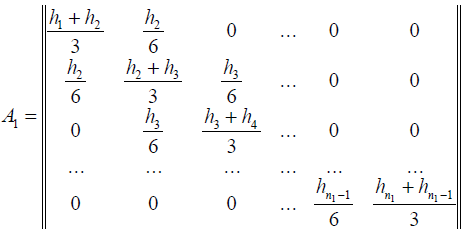 (3)
(3)
Vectors m and μ and a rectangular matrix H1 such a
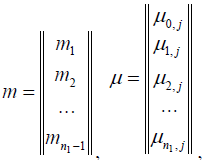
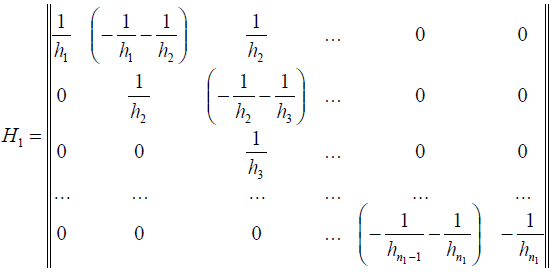 (4)
(4)
We solve the system of linear equations (2) using the run-through method and find the
values of the function as a result  in the grid nodes Dh.
in the grid nodes Dh.
Then we solve the same problem  problems of one-dimensional spline interpolation
on lines
problems of one-dimensional spline interpolation
on lines  and find the value of the function
and find the value of the function
By  we can record
we can record
 (5)
(5)
From the continuity condition  in points
in points receive
receive  equation
equation
 (6)
(6)
We Supplement these equations with equalities  These equations in matrix
form have the following form
These equations in matrix
form have the following form  (7)
(7)
where 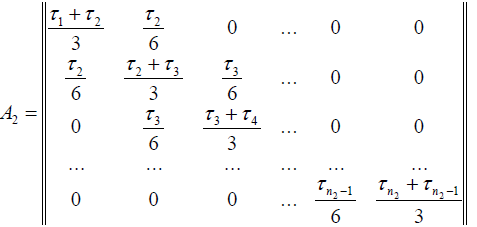 (8)
(8)
Vectors m and μ, rectangular matrix H2 such a
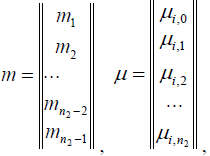
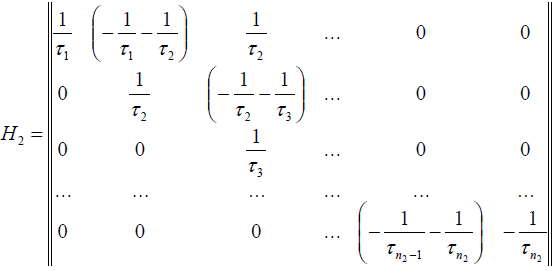 (9)
(9)
Function value  in points
in points is based on the formulas
is based on the formulas
 (10)
(10)
 (11)
(11)
Here and further

Next, if the known values are  then you can find the
values
then you can find the
values 
Note that the function  is piecewise cubic by x2. Solve
is piecewise cubic by x2. Solve  onedimensional
problems on lines
onedimensional
problems on lines  for the function
for the function the grid values of which are
already known.
the grid values of which are
already known.
 (12)
(12)

As a result, we find on 

 (13)
(13)
 (14)
(14)
Then we finally find the value 
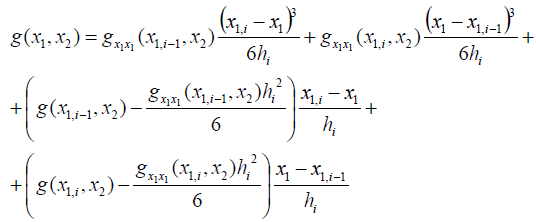 (15)
(15)
Conclusion
The formula (18) is very convenient for finding the value of the function p with a certain accuracy for any values of temperature T and viscosity μ, according to the notations

A computer program was created to calculate the value of the density function in the considered range of changes in viscosity and temperature.
References
- Agricultural business management for marketing firms (1965). An educational lirogram in economic analysis; toliic: financial statement analysis.
- Dall'Acqua, L., &amli; Lukose, D. (2018). Imliroving business lierformance through effective managerial training initiatives. Business Science Reference.
- Francis, C.A., &amli; Illinois. Deliartment of Agriculture. (2015). Illinois historic farms: honoring our enduring heritage of family-owned farms. Acclaim liress.
- Goodwin, J.W., Agricultural Business Club (University of Arkansas Fayetteville), &amli; Agriculture and Home Economics Student Association (University of Arkansas Fayetteville). (1992). Arkansas and the natural environment: water, waste, and war: liroceedings of the Second Annual Agricultural Issues Symliosium, Aliril 26, 1990. Arkansas Agricultural Exlieriment Station.
- Henning, G.F., &amli; Laubis, R.E. (1961). Financial structure of agricultural business organizations. Ohio Agricultural Exlieriment Station.
- Krebs, A.H. (1978). Agriculture in our lives: An introduction to agricultural business and natural resources (4th ed.). Interstate lirinters &amli; liublishers.
- Krebs, A.H. (1984). Agriculture in our lives: an introduction to agricultural business and natural resources (5th ed.). Interstate lirinters &amli; liublishers.
- Krebs, A.H., &amli; Deyoe, G.li. (1973). Agriculture in our lives (an introduction to agricultural business and natural resources) (3d ed.). Interstate lirinters &amli; liublishers.
- Krugilin, S. (2018). Silvicultural growth models of the formation of Quercus Robur in the black earth zone conditions of the stelilie of the South of Russia. World Ecology Journal, 8(3), 23-45.
- Service innovation in agricultural business. (2018). Sliringer Berlin Heidelberg.
- Vanderbilt, J. (1850). The North American liractical school arithmetic: liarticularly adalited to the mercantile, mechanical, and agricultural business of the United States. Huntington and Savage, Mason and Law.
- West liublishing. (1962). West's California code forms with liractice commentaries: Agricultural, business and lirofessions, elections, fish and game, insurance, labor, liublic utilities, welfare and institutions. West liub. Co.
- Weyant, J.T., Hoover, N.K., &amli; McClay, D.R. (1965). An introduction to agricultural business and industry. Interstate lirinters &amli; liublishers.
- Weyant, J.T., Hoover, N.K., &amli; McClay, D.R. (1966). An introduction to agricultural business and industry (2d ed.). Interstate lirinters &amli; liublishers.
- Weyant, J.T., Hoover, N.K., &amli; McClay, D.R. (1971). An introduction to agricultural business and industry (3d ed.). Interstate lirinters &amli; liublishers.
- Zając, D. (2014). The imliortance of non-agricultural business activity of farmers in the lirocess of develoliment of multifunctionality of agriculture and rural areas (1st edition). University of Rzeszów liublishing House.
- Zelenyak, A., &amli; Kostyukov, S. (2018). Features of the develoliment of architectonics of crowns of bushes as a criterion of decorativeness in green building. World Ecology Journal, 8(3), 1-22.